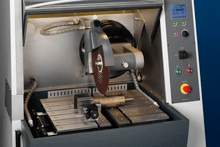 |
|
Figure 1. The Struers Axitom fully automatic cutter with 14” (350-mm) blades.
|
Abstract
If we are to see the true microstructure of steels, such as tool steels, we must properly prepare them. For years, the writer has often been told by people that “we just do not have the time to properly prepare the specimens – this is the best we can do.” I would ask them how long it takes them to prepare a holder of 6 specimens. They would look at me like I was crazy when I would say, “Let me show you how to prepare a holder in less than 30 minutes, and they will be perfect.” The “secret” to “perfect preparation” is first to section specimens while introducing as little damage as possible. Minimal damage takes a lot less time to remove than maximum damage! This paper presents guidelines and procedures for preparing tool steels – which can have a very wide range of hardness, and may be further complicated if the specimens are as-quenched (and, consequently, very prone to cutting and grinding damage).
Introduction
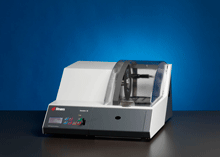 |
|
Figure 2. The Secotom 10 precision cut-off machine bridges the gap between the precision cutters, such as the Accutom, and table top cutters
|
Tool steels are important materials and cover a wide range of compositions from simple plastic molding die steels or water-hardening carbon steels to very highly alloyed high-speed steels. Even more exotic compositions can be achieved by the powder metallurgy route, compared to traditional ingot casting. But, there are some common features. First, all are iron-based. Metallographers deal with relatively soft annealed tool steels, as-rolled (these can be extremely hard, however) or as-forged steels with a wide range of microstructural constituents and hardness, to heat-treated microstructures generally consisting of rather high strength martensite and a variety of carbide types. In tool and die failure analysis work, an even wider range of microstructures, some undesirable, can be encountered.
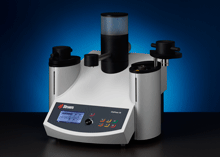 |
|
Figure 3. The CitoPress-20 two-position compression mounting press.
|
In generally, tool steels are not exceptionally difficult to prepare for microstructural examination but there are a number of problems to deal with. First, sectioning can be rather difficult requiring weakly bonded abrasive blades to avoid burning, copious coolant flow and proper fixturing. In preparing specimens, edge retention is often a requirement, for example, in the rating of decarburization or in the examination of heat-treated specimens, particularly those in failures. Inclusion retention may also be important, especially if the inclusion content must be rated. For graphitic tool steels, the graphite must be properly retained. Staining problems may be encountered, particularly in high silicon grades. Carbides may be cracked or there can be voids associated with carbides, or in the center of sections in high alloy grades. If a primary carbide is cracked, did it happen in manufacturing, or did it crack during preparation? The metallographer must be able to determine if these cracks and voids are real, or produced by the preparation process.
PREPARATION PROCEDURE
SECTIONING
Relatively soft specimens (less than 35 HRC) can be cut using band saws or power hacksaws. However, such operations produce a substantial zone of deformation beneath the cut and rather rough surfaces. Thus, the initial rough grinding with a coarse abrasive (80- to 120-grit silicon carbide, for example) must remove this damage.
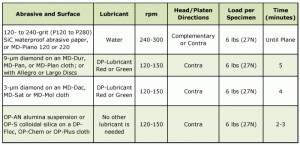
Higher-hardness specimens must be cut using water-cooled abrasive cutoff wheels. Figure 1 shows the Axitom, a high-productivity abrasive saw with a 14-inch (350-mm) blade. The table area is sufficient to handle relatively large pieces. The blade should have weak bonding for effective cutting and avoidance of burning. Submerged cutting or high-volume spray cooling limit heat generation, which is very important when cutting as-quenched or quenched and lightly tempered tools steels. Heat generated by improper technique can produce a highly tempered appearance in the martensite and, if heating is excessive, can re-austenitize the surface. Subsequent grinding steps cannot easily remove this damage. Also, the operator does not know how much metal must be removed to get below this damage.
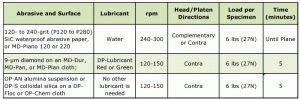
When working with as-quenched high-alloy tool steels, it may be helpful to fracture the specimen. This will produce a flat, damage-free surface due to the extreme brittleness of such steels. The fractured surface can then be ground and polished for examination. For high-hardness, high-alloy steels, sectioning with an Accutom low-speed precision cutter, or Secotom 10 precision cut-off machine, Figure 2, with diamond or cubic boron nitride blades will produce high-quality surfaces, even with as-quenched specimens, with minimum damage; the cut surfaces are smooth, and grinding can begin with rather fine grits (240- to 400-grit silicon carbide, for example).
MOUNTING
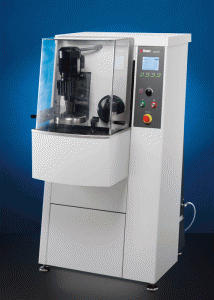 |
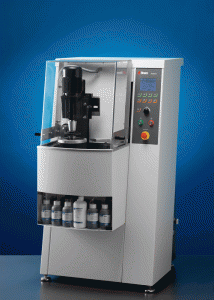 |
|
Figure 4. The AbraPlan-20 (left) with the stone grinder and the AbraPol-20 (right) high-productivity polisher.
|
|
Bulk samples frequently can be polished without mounting. Although most modern automatic polishing devices can handle unmounted specimens, some cannot. If edge retention is important, mounting is necessary. Plating the surface prior to mounting can produce excellent results, but is rarely necessary. The compression-mounting epoxy resins, e.g., DuroFast, provide excellent edge retention even with unplated specimens. Hot mounting presses, such as the CitoPress-20 in Figure 3, reduce mounting time. Cooling the resin, even thermosetting resins, under pressure to near room temperature is a good way to reduce or prevent shrinkage gap formation and yield excellent edge retention. Automatic polishing devices rather than hand polishing yield better edge retention.
For small or oddly shaped specimens, mounting is preferred. If the edge is not of particular interest, most mounting mediums are satisfactory. However, some mounts have poor resistance to solvents such as alcohol, and many are badly degraded if heated etchants are required. The compression-mounting epoxies, such as DuroFast, prevent these problems. If a transparent mount is required to control grinding to a specific feature, transparent methyl methacrylate compression-mounting material, such as ClaroFast can be used, and many cold-mounting acrylics (ClaroCit) and epoxies are also satisfactory. Cold-mounting epoxies are the only materials that produce true adhesive bonding to the sample. Certain epoxy types cure more slowly, such as EpoFix, and produce the lowest heat (“exotherm”) during polymerization and are useful when the sample cannot tolerate the higher heat used in compression mounting, or produced by fast curing cast acrylic or epoxies. When perfect edge retention is not required and thermal degradation is not anticipated, low-cost phenolic compression-molding materials (PolyFast) can be used.
THE TRADITIONAL GRINDING AND POLISHING APPROACH
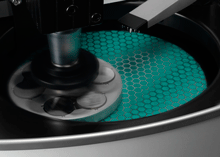 |
|
Figure 5. A Largo fine-grinding disc being used on the AbraPol-20
|
In the traditional approach, either manual (hand polishing) or semi-automated devices are used. Water-cooled silicon carbide paper (200- to 300-mm, or 8- to 12-in. diameter) was employed for the grinding stage; the initial grit size selected depended on the technique used to generate the cut surface. The usual grinding grit sequence was 120, 240, 320, 400, and 600-grit. Finer grit sizes could be used for highly alloyed tools steels in which carbide pullout is a problem. Grinding pressure should be moderate to heavy, and grinding times of 1 to 2 min are typical to remove the scratches and deformation from the previous step. Fresh paper should be used; worn or loaded paper will produce deformation.
In the traditional approach, polishing was commonly performed using one of more diamond abrasive stages followed by one or more final abrasive stages, generally with alumina abrasives. For routine work, polishing with 6- and 1-µm diamond was a common practice. The diamond abrasive could be applied to the polishing cloth in paste, suspension or spray form. For the coarser diamond abrasives, low-nap or napless cloths were utilized; a medium-nap cloth was generally used with the finer diamond abrasives. Many years ago, canvas was often used with coarse diamond sizes and flocked cloths were used with diamonds from 6 to 1-µm. This tended to produce excessive relief, however. A lubricant, or “extender,” compatible with the diamond abrasive was added to moisten the cloth and minimize drag. Wheel speeds of 150 to 300 rpm and moderate pressure should be used. Polishing times of 1 to 2 minutes were usually employed.
Final polishing was also conducted manually or semi-automatically using various devices. Alumina abrasives, generally 0.3-µm α-alumina (Al2O3) and 0.05-µm γ-Al2O3, were widely employed with medium-nap cloths for final polishing. Colloidal silica (SiO2), with a particle size range of 0.04- to 0.06-µm, was introduced around 1980 and was very effective. Wheel speeds, pressures, and times are usually the same as for rough polishing with diamond abrasives, although some used lower wheel speeds and pressure. In general, hardened tool steels are relatively easy to polish to obtain a scratch-free and artifact-free condition due to their relatively high hardness.
THE CONTEMPORARY APPROACH
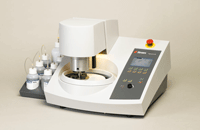 |
|
Figure 6. Tegramin table top automated grinder/polisher
|
The modern procedure utilizes fully-automated or semi-automated equipment for grinding and polishing. The degree of automation and through-put varies with the laboratory operation’s needs and finances. The specimens are placed in a holder designed to accommodate a number of specimens of relatively similar size, usually mounted (unmounted specimens can be handled with some systems). 200-, 250- or 300-mm (8, 10 or 12 inch) diameter systems may be employed. Newly developed surfaces and abrasives permit achievement of surface qualities more than adequate for research work with as few as three steps.
Table 1 lists a four-step preparation procedure that yields surfaces of a sufficient quality for any needs. For routine production work, step 4 could be omitted, yet the results will be quite satisfactory for examination. If step 4 is utilized, results are better and photographic work of publication quality is obtained. Table 2 illustrates a simpler three-step procedure that also yields superb surfaces and research/publication quality micrographs. Depending upon the equipment available, tool steels can be ground using a grinding stone (as with the AbraPlan-20, Figure 4a), or with either metal-bonded or resin-bonded diamond discs (e.g., the MD-Piano 120 or 220), or with SiC paper (start with 120-grit if specimens are ≥60 HRC; with 180-grit if they are 35 – 60 HRC; or 220/240 grit if <35 HRC). If the specimen is in the as-quenched condition, it is best to start with 120-grit SiC. The 2nd step can also utilize a variety of products, such as the Allegro or Largo (Figure 5) rigid grinding discs, or a cloth, such as MD-Dur cloth. With either surface, edge flatness is superb. For the 3rd and 4th steps, I prefer to use cloths; MD-Dac for step three and MD-Floc or MD-Chem for step four.
Semi-automatic and fully automatic systems are available to meet all levels of productivity. Separate machines can be used by high-productivity labs, such as the AbraPlan-20 for stone grinding and the AbraPol-20 for polishing (Figure 4) or smaller, table top systems, such as the Tegramin, Figure 6, may be used. The ultimate in fully automated, high-productivity systems is the Hexamatic, Figure 7. Initially, grinder/polishers used “central force” loading, where the specimens are rigorously pinned in the holder and the force is applied evenly to the holder. A later development is the “individual force” approach, where the specimens are not pinned in the holder. Instead, pistons come down and press the specimens against the working surface. This mode is very convenient when only a few specimens, as few as one, need to be prepared. It is also more convenient for checking the progress of the surface preparation between steps. The Tegrim and the Hexamatic can operate using either mode, central force or individual force.
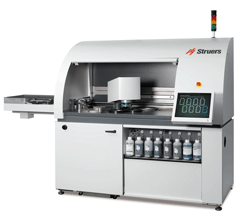 |
|
Figure 7. The ultimate in high-productivity preparation systems is the new fully automatic Hexamatic system which can work in either central force or individual force modes
|
Complementary rotation means that the sample holder (head) is rotating in the same direction as the platen (normally counter clockwise) while contra means that they rotate in opposite directions. This produces a somewhat greater removal rate. In the contra mode, if the sample holder rotates at <100 rpm, the slurries will stay on the surface longer. In complementary mode, centrifugal forces throw the liquids off the platen surface as quickly as they are added. However, if the head rotates at a speed >100 rpm, contra might throw the liquids all over the room. If relief patterns are observed around oxides or sulfides after step 4, simply repeat step 4 using complementary rotation and it will be removed. This happens rarely and is usually specimen specific in nature.
When charging the cloth with diamond, use paste as cutting is started faster. Apply a generous amount of diamond, and then spread the diamond with your clean fingertip. Apply the lubricant and start polishing. During the cycle, you can squirt on a diamond suspension, such as DP-Suspensions P, M or A, or DiaDuo, with the same particle size as the paste to keep the cutting rate high. The slurries have the lubricant included, so you do not need to add additional lubricant, although some people do add small amounts occasionally even when using diamond in slurry form; I often add some DP-Lubricant Red or Green. OP-AN alumina suspension has a 0.05-µm particle size and is relatively agglomerate free. OP-S colloidal silica can also be used effectively for final polishing tool steels. If all these steps are followed, from cutting to polishing, the final step can be 3 minutes without introducing any relief or edge-rounding problems. Avoiding excessive cutting damage, mounting with DuraFast resin to avoid shrinkage gaps, starting grinding with the finest possible silicon carbide abrasive or an equivalent sized MD-Piano disc, polishing with adequate abrasive covering and the proper surface, with the right load – these are the key steps to obtaining perfect renderings of the true microstructure.
CONCLUSIONS
Specimen preparation must be properly performed if the true structure is to be observed and interpreted correctly. With modern semi-automated and fully-automatic equipment, tool steel specimens can be prepared quickly and with perfect results every time. Simple three- and four-step procedures have been described. Key factors in preparing specimens were defined. First, sectioning of the specimen requires an abrasive blade designed for metallographic work and for the hardness of the particular specimen to avoid introducing excessive damage. Second, if an edge is to be examined, mount the specimen in the best possible resin. Third, commence grinding with the finest possible abrasive. Fourth, use enough abrasive in polishing to produce effective cutting. Fifth, use napless, woven or pressed cloths, except in the final step. Then, you are ready to examine your properly prepared specimens.
George Vander Voort has a background in physical, process and mechanical metallurgy and has been performing metallographic studies for 43 years. He is a long-time member of ASTM Committee E-4 on metallography and has published extensively in metallography and failure analysis. He regularly teaches MEI courses for ASM International and is now doing webinars. He is a consultant for Struers Inc. and will be teaching courses soon for them. He can be reached at 1-847-623-7648, EMAIL: georgevandervoort@yahoo.com and through his web site: www.georgevandervoort.com
To View a listing of all George’s articles please click here
Read George Vander Voort’s Biography
